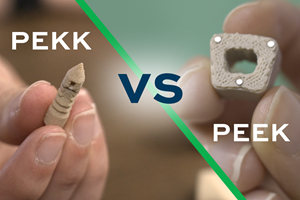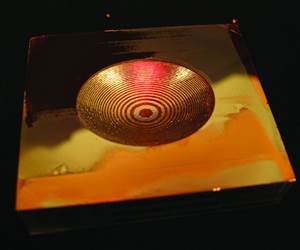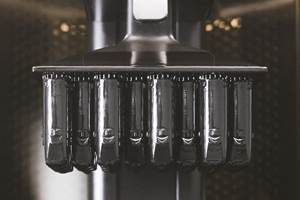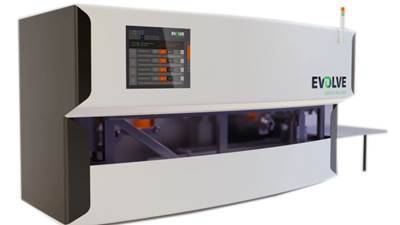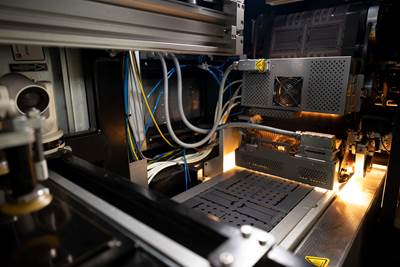AM 101: Selective Thermoplastic Electrophotographic Process (STEP)
Learn about Selective Thermoplastic Electrophotographic Process (STEP): how it works, the comparative benefits and where it is leading additive production in the future.
Share
What Is Selective Thermoplastic Electrophotographic Process (STEP)?
Developed by Evolve Additive Solutions, Selective Thermoplastic Electrophotographic Process (STEP) technology combines 2D imaging with proprietary IP to precisely align incoming layers and bond them into final parts that are fully dense, with isotropic properties said to be equal to or exceed injection molding.
Designed for high-speed, high-volume additive manufacturing and factory-floor integration, STEP performs nothing like the stereolithography processes where 3D printing began. But the irony in avoiding this term is that STEP has as much in common with actual printing as any additive system so far. The technology achieves high-speed material layering by applying polymer onto rollers like toner in a document printer.
STEP allows users to utilize production-grade thermoplastics for volume manufacturing applications across multiple industries, including consumer, automotive, industrial and medical.
Read how Evolve Additive Solutions’s STEP is competing with conventional manufacturing.
How Does STEP Work?
In STEP, the layers are applied like toner, with a belt that delivers material onto a preheated part that is moving at a matching speed. The belt carries an entire layer at once, aligning with and meeting the part as it moves in a straight line beneath the belt on a conveyor of its own. Delivering each layer in this way allows for rapid build rates. The first machine model developed offered a build chamber measuring 24 × 13 × 6 inches. One layer across its 24 × 13-inch area could be applied in 4 seconds. Filling the entire volume with parts — however many parts can be fit into that space — took 3 hours.

“It’s not only exciting but critical that we get the technology into a customer’s hands for development of real-world applications,” says Steve Chillscyzn, CEO of Evolve Additive Solutions.
What Materials Can Be Used?
Candidate materials for STEP are the same polymers available for injection molding, the company says. However, delivering the materials as toner requires materials-engineering techniques proprietary to Evolve.
The STEP machine (even in its current alpha form) has multiple print heads. This can allow for multiple colors in the part, but another possibility is the chance for multiple materials. Various different polymers applied at the voxel-by-voxel level could achieve combinations of properties unobtainable in any single material alone.
Why Use STEP?
The capabilities of STEP are more comparable to short-run injection molding than to other additive processes. STEP provides a way to obtain several thousand plastic parts within days, versus the weeks of lead time that might be necessary to wait for mold tooling. And because the mold is absent, the new technology also delivers a cost per piece at this quantity level that is lower than molding.
One other way the process is comparable to molding is this: The process can produce parts missing the layer lines typical of 3D printing. STEP mates heated layers to a heated part, producing fusion that is more complete than in a process such as FDM.
The part-design possibilities are very new. The STEP process has parts passing conveyor-style under the belt applying material, meaning the conveyor could also carry parts — including incomplete parts — to separate processing stations. For example, the unfinished part could pass to assemblers or robots for quick installation of electronics before being sent back into the additive build. The result would be low-cost solid parts with electronics sealed inside.?
STEP was released commercially in 2020. Evolve has claimed that it offers full isotropic properties in all directions, making it a comparable part performance to injection molded parts. STEP is hoped to be a step toward making 3D printing a true production technology that can be used on factory floors alongside injection molding and other technologies.
Related Content
Understanding PEKK and PEEK for 3D Printing: The Cool Parts Show Bonus
Both materials offer properties desirable for medical implants, among other applications. In this bonus episode, hear more from Oxford Performance Materials and Curiteva about how these companies are applying PEKK and PEEK, respectively.
Read MoreAM 101: What is Ultrasonic Additive Manufacturing?
Going from additive to subtractive can be simple with Ultrasonic Additive Manufacturing (UAM). What is it and how does it work? Learn the basics in this 101 post.
Read More8 Cool Parts From Formnext 2023: The Cool Parts Show #65
New additive manufacturing technologies on display at Formnext were in many cases producing notable end-use components. Here are some of the coolest parts we found at this year’s show.
Read MoreAM 101: Digital Light Synthesis (DLS)
Digital Light Synthesis (DLS) is the name for Carbon's resin-based 3D printing process. How it works and how it differs from stereolithography.
Read MoreRead Next
Applying Material Like Toner Promises AM at Speeds Like Injection Molding
The Stratasys-founded company Evolve debuts its STEP technology for production-scale additive processing.
Read MoreCan Additive Manufacturing Compete With Conventional Manufacturing on Cost?
When it can, says Evolve, the design advantages of AM find their way in. The company is beginning to ship its high-speed AM system for polymer part production.
Read More3D Printing Brings Sustainability, Accessibility to Glass Manufacturing
Australian startup Maple Glass Printing has developed a process for extruding glass into artwork, lab implements and architectural elements. Along the way, the company has also found more efficient ways of recycling this material.
Read More





